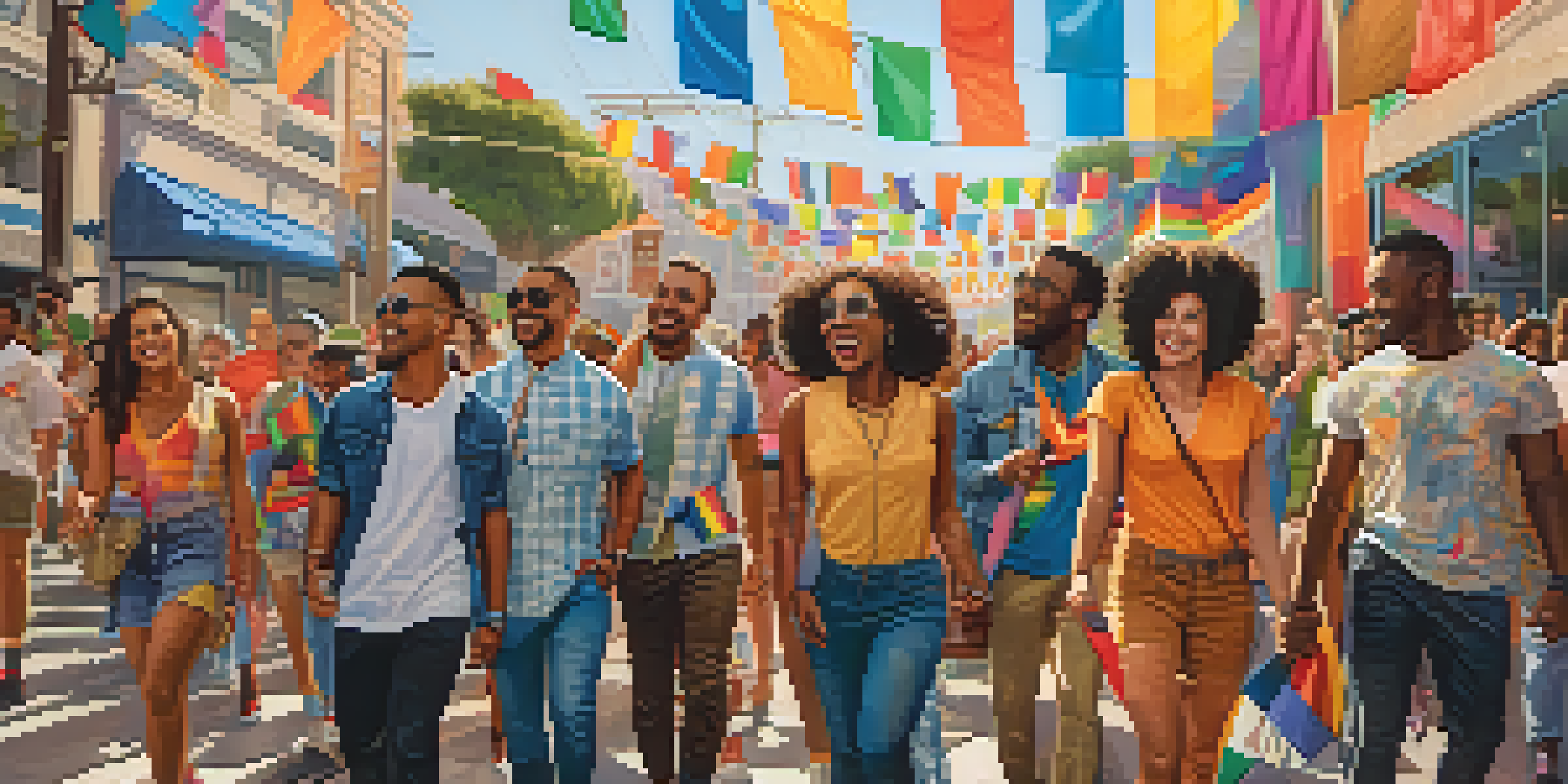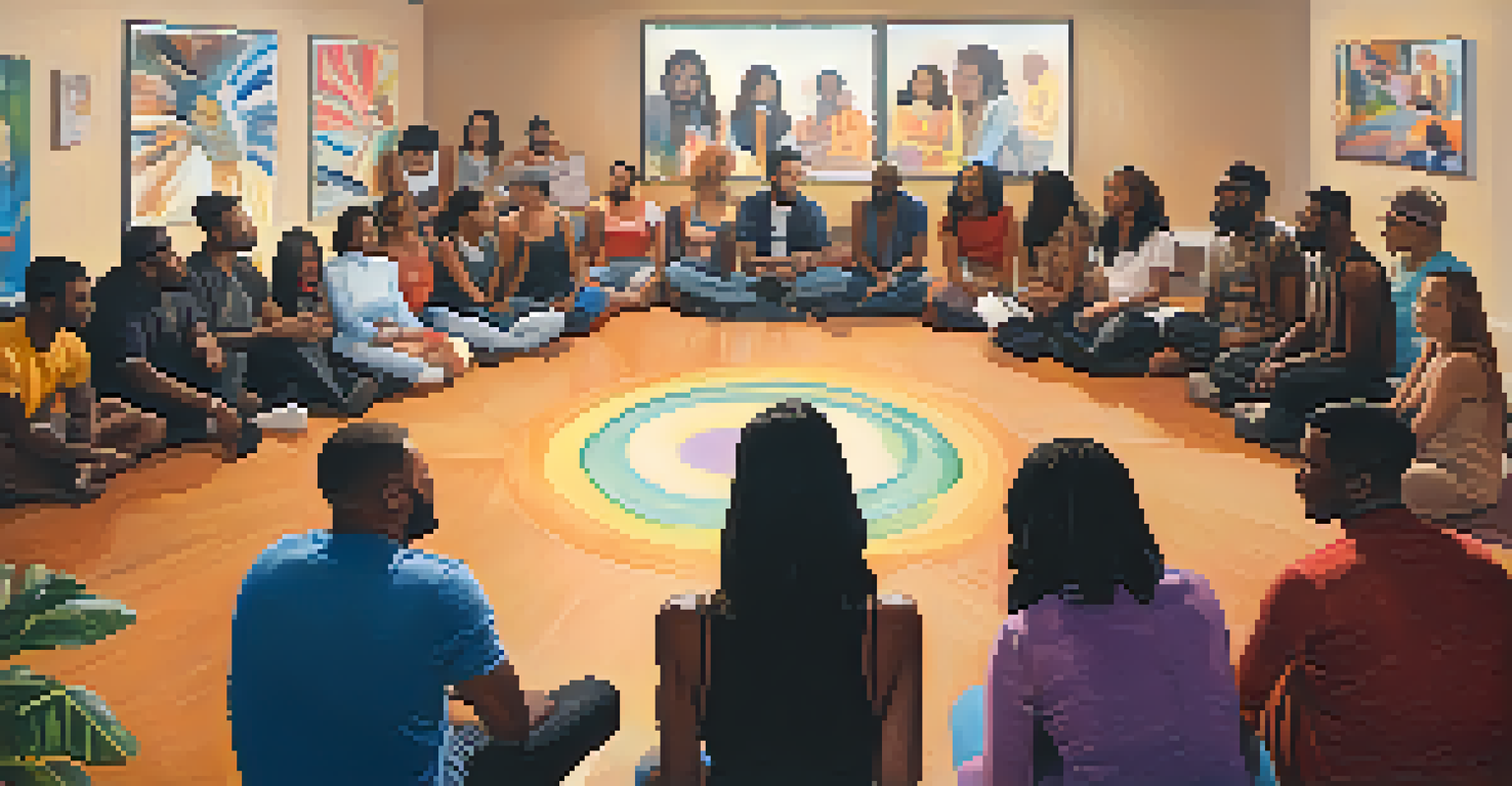The Intersection of Race and LGBTQ+ Identity in Los Angeles

Understanding Race and LGBTQ+ Identity in Los Angeles
Los Angeles is a vibrant tapestry of cultures, yet the intersection of race and LGBTQ+ identity can present unique challenges. With its diverse population, the city showcases a rich blend of experiences, but these can often be complicated by societal norms surrounding race and sexuality. Understanding this intersection is crucial for fostering inclusivity and acceptance within the community.
In diversity there is beauty and there is strength.
For many LGBTQ+ individuals of color, navigating their identities can feel like walking a tightrope. They often face discrimination not just for their sexual orientation but also for their race, leading to feelings of isolation. This dual struggle can create a complex identity that is both rich and challenging, requiring a nuanced approach to understanding.
The experiences of LGBTQ+ people of color in Los Angeles highlight the need for dialogue and understanding. By recognizing the unique challenges they face, we can work towards creating a more inclusive society that respects and uplifts all identities, paving the way for greater acceptance.
Historical Context: Race and LGBTQ+ Movements
To fully grasp the intersection of race and LGBTQ+ identity, it's important to look at the historical context of both movements. The LGBTQ+ rights movement has its roots in struggles against discrimination and violence, paralleling the civil rights movement that fought for racial equality. In Los Angeles, these movements have often intersected, shaping the experiences of marginalized communities.

Key events, like the Stonewall Riots, were not only pivotal for LGBTQ+ rights but also highlighted the racial dynamics within the movement. Many activists of color played crucial roles, yet their contributions have sometimes been overshadowed. This historical oversight has created a need for a more inclusive narrative that honors the diverse voices within both movements.
Intersection of Race and LGBTQ+ Identity
Understanding the unique challenges faced by LGBTQ+ individuals of color is essential for fostering inclusivity in Los Angeles.
By exploring this history, we can better appreciate how race and LGBTQ+ identities have evolved together. Understanding this legacy allows current activists to draw from the past, ensuring that both racial and sexual identities are represented and celebrated in the ongoing fight for equality.
The Role of Community Centers in Supporting Diversity
Community centers play a vital role in supporting LGBTQ+ individuals, particularly those from diverse racial backgrounds. In Los Angeles, organizations like the Los Angeles LGBTQ Center offer resources, safe spaces, and programs tailored to the unique needs of these communities. This support is crucial for fostering a sense of belonging and acceptance.
The only way to make a difference is to be the difference.
These centers often host events that celebrate cultural diversity while promoting intersectionality within the LGBTQ+ community. By creating spaces where individuals can express both their racial and sexual identities, these organizations help to combat feelings of isolation. They provide a platform for dialogue, encouraging understanding and solidarity among various groups.
Moreover, community centers serve as hubs for activism, empowering individuals to advocate for their rights. By equipping LGBTQ+ people of color with the tools they need to navigate societal challenges, these organizations contribute to a more equitable society, ensuring every voice is heard and valued.
Challenges Faced by LGBTQ+ People of Color
Despite the progress made, LGBTQ+ individuals of color still encounter significant challenges in Los Angeles. Discrimination, both systemic and interpersonal, can affect their access to healthcare, employment, and safe housing. These barriers often stem from a lack of understanding and acceptance, underscoring the need for continued advocacy.
Additionally, mental health issues are prevalent among LGBTQ+ people of color due to the compounded stress of facing racism and homophobia. Many may feel pressured to choose between their racial identity and their sexual identity, leading to internal conflict. This struggle can result in feelings of inadequacy and isolation, further exacerbating mental health challenges.
Community Centers as Safe Spaces
Organizations like the Los Angeles LGBTQ Center provide vital resources and support for LGBTQ+ people of color, promoting belonging and advocacy.
Addressing these challenges requires a multi-faceted approach that includes education, advocacy, and support systems. By recognizing the unique experiences of LGBTQ+ people of color, we can create strategies that promote healing and empowerment, ensuring they receive the support they need to thrive.
Celebrating Intersectionality: Art and Representation
Art has long been a powerful medium for expressing the intersectionality of race and LGBTQ+ identity. In Los Angeles, artists from diverse backgrounds use their work to highlight their experiences, challenge stereotypes, and foster dialogue. This creative expression serves not only as a means of personal reflection but also as a catalyst for social change.
Exhibitions, performances, and festivals that celebrate these intersections allow for greater visibility and representation. They create opportunities for marginalized voices to be heard, showcasing the richness of experiences that exist within the LGBTQ+ community. By amplifying these narratives, we can challenge dominant cultural norms and inspire others to embrace diversity.
Moreover, supporting LGBTQ+ artists of color is crucial for fostering a vibrant cultural landscape. By investing in their work, we acknowledge the importance of their perspectives and contribute to a narrative that values inclusivity and representation in all forms.
The Importance of Allyship in the Community
Allyship plays a critical role in creating a supportive environment for LGBTQ+ individuals of color in Los Angeles. Allies can help amplify marginalized voices, challenge discriminatory practices, and promote understanding within their communities. By standing in solidarity, allies contribute to a culture of acceptance and respect.
Being an effective ally means actively listening and learning about the unique experiences of LGBTQ+ people of color. This involves acknowledging one's privilege and using it to advocate for change. Allies can participate in community events, support local organizations, and educate themselves on issues that affect these communities.
Importance of Allyship for Change
Effective allyship amplifies marginalized voices and helps dismantle systemic barriers, contributing to a more inclusive environment for LGBTQ+ individuals of color.
Ultimately, allyship is about building relationships based on trust and mutual respect. When allies work collaboratively with LGBTQ+ individuals of color, they help to dismantle systemic barriers and create a more inclusive society. Together, we can foster an environment where everyone feels valued and celebrated for who they are.
Looking Forward: Hope and Progress in Los Angeles
As we look to the future, there is hope for continued progress at the intersection of race and LGBTQ+ identity in Los Angeles. Community initiatives, advocacy efforts, and grassroots movements are working tirelessly to create spaces of inclusivity. These efforts are essential in ensuring that all voices are heard and valued in the fight for equality.
The increasing visibility of LGBTQ+ individuals of color in media, politics, and the arts also signals a shift towards greater acceptance. As these narratives gain prominence, they challenge stereotypes and encourage others to embrace diversity. This cultural shift lays the groundwork for a more inclusive society where everyone can thrive.

While challenges remain, the resilience of the LGBTQ+ community, particularly those of color, offers a powerful testament to the strength found in diversity. By continuing to advocate for change and support one another, we can build a future that honors and uplifts every identity, forging a path towards true equality.